Once upon a time there was an Irish giant named Finn MacCool who lived on the shores of Northern Ireland with his wife and infant. Finn was definitely a cool guy, but he was short, as giants go. He stood only 52-feet, 6 inches tall. Across the Sea of Moyle in Scotland lived a proper huge giant named Benandonner, who was not so cool. Benandonner was constantly yelling across the water at Finn, claiming to be the stronger giant.
One day, Finn decided to build a causeway across the sea so the two could meet for a contest. Finn worked tirelessly, laying sections of the dense local rock in an interlocking pattern leading to Finegal’s Cave on the island of Staffa, where Benandonner lived. He laid the final stone in darkness and, exhausted, returned home and fell fast asleep.

The next morning, Benandonner strode across the causeway, eager to do battle. His thunderous footsteps woke Finn’s wife, Oonagh, who took one look at Benandonner and realized her husband was doomed. The quick-thinking Oonagh covered her sleeping husband with one of her nightgowns and tied a bonnet on his head. A moment later, Benandonner confronted her. “Where’s that coward husband of yours,” he demanded. “Shhh!” replied Oonagh, stepping aside to reveal her husband in peaceful repose. “You’ll wake the baby.” Benandonner panicked. If the baby was this big, how much larger would Finn be? He fled back to his cave, tearing up the causeway in his wake, so that Finn could not follow.
This delightful story refers to what is today known as the Giant’s Causeway on the Causeway Coast of Northern Ireland. It has, of course, no basis in fact. Today we know the causeway is the result of geologic and volcanic forces. The interlocking Basalt columns formed when an earlier (but still hot) lava flow was covered by a later eruption. The heat and pressure of the overlying lava allowed the underlying layer to cool slowly and crystallize. Over eons, the top layer was eroded and the Basalt columns were exposed. Early settlers, who had no understanding of these forces, needed an explanation for the weirdly symmetrical rocks that looked like paving stones, and the legend of Finn MacCool was born.
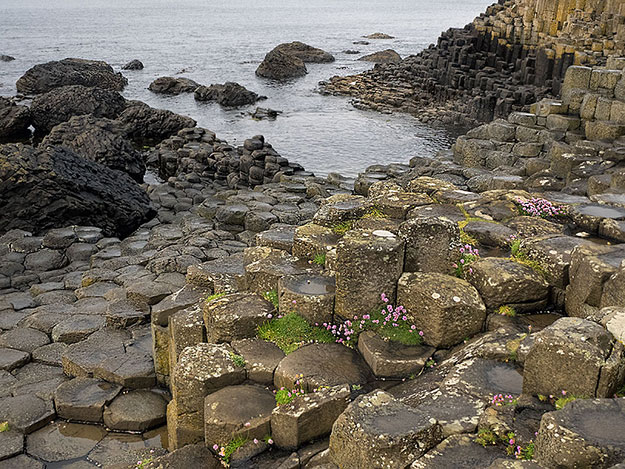
The Giant’s Causeway is undoubtedly the best-known of the attractions along the Causeway Coast. But as I discovered during my day with owner the of Glenara Elite Travel, Frances Gailbreath, this area of Northern Ireland has far more to offer. Frances started her tour company after 21 years as an Ulster bus driver because she felt that visitors were not getting a thorough experience of the Causeway Coast. “Bus service is not available to many of the sites year-round,” she explained. “Visitors were seeing the Giant’s Causeway and maybe the Carrick-a-Rede Rope Bridge, but they were missing everything else.” About a year ago, Frances acquired a small, luxury tour bus that could navigate the narrow, winding roads that larger tour buses cannot access, and started Glenara Elite Travel.
In a stroke of genius, she also hired two local guides so she could “do what she does best – drive.” One of them, Mark Rodgers of Dalriada Kingdom Tours, joined us on the morning I took Frances’ North Coast Tour. Mark flashed his broad, toothy smile and began expounding on the Causeway Coast. It is a subject about which he is naturally passionate, since members of his extended family have been guides on the Causeway Coast for three generations.
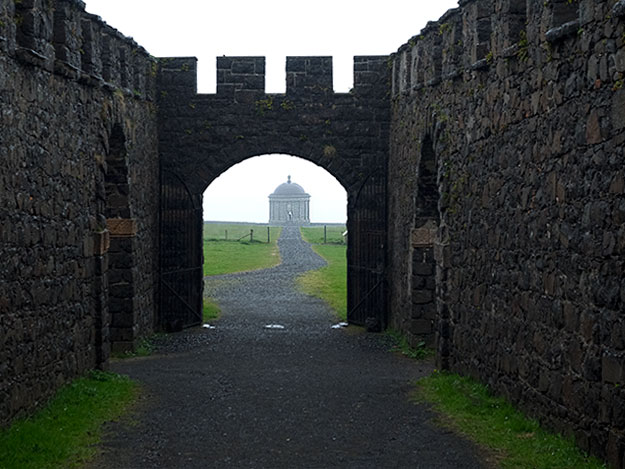
We began at Downhill Demense (Estate) and Mussenden Temple. Now in ruins, it was once a stunning mansion with 365 Windows – one for every day of the year. Playing to the gloomy day, Mark spun tales of unrequited love and a maiden who died too soon, some say of heartbreak. Next was Portstewart Strand (beach), where the sands managed to shine golden even under dreary skies. At Whiterocks Coastal Park I stood atop a high bluff and marveled over the white chalk cliffs that have been exposed by centuries of lashing waves.
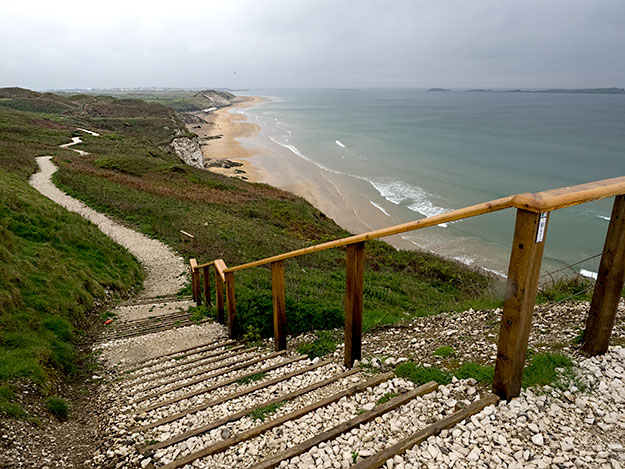
Not much further down the coast stood the ruins of the medieval Dunluce Castle, built upon a Basalt outcropping connected to the mainland by a wooden bridge. So precarious was its perch that the entire kitchen plunged into the sea on a stormy night in 1693. Stinging rain pelted me as I peered over the remains of the north wall. Black thunderheads raced overhead and raging waves pummeled the base of the pinnacle. There was nothing to prevent more of it from sliding into the raging seas, taking me with it. Feeling suddenly very vulnerable, I turned and headed back to terra firma.
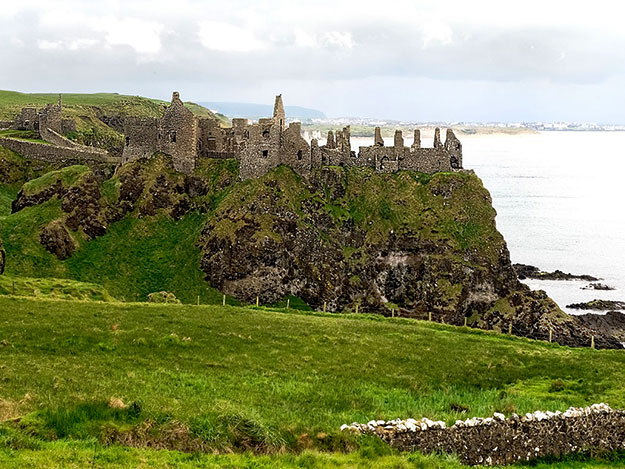
My final stop with Mark was at Giant’s Causeway. He pointed out fascinating formations such as the organ, the wishing chair, and the giant’s boot, before delving deeply into the history and geology of the site. I was amazed to learn that the basalt columns had actually been mined and sold for many years, in the days before people understood the rare nature of the formation.

After lunch, we picked up our second expert, Caroline Redmond from North Coast Walking Tours. Also a native of the area, Caroline not only knew the local lore of the Causeway Coast, she also filled us in on which scenes in the Game of Thrones series has been filmed at Ballintoy Harbor and the Bay of Larrybane.

Like Mark, however, she obviously had a favorite attraction. Her exuberance virtually bubbled over at Carrick-a-rede, where a famous rope bridge connects the mainland to an offshore sea stack. This area of the North Atlantic has always offered abundant Salmon catches for local fishermen, but steep cliffs and crashing waves offered no safe landings places on the shore. The ever ingenious fishermen docked instead at the base of the stack, winched their boats up to the top, and carried their catch across the rope bridge to the mainland.
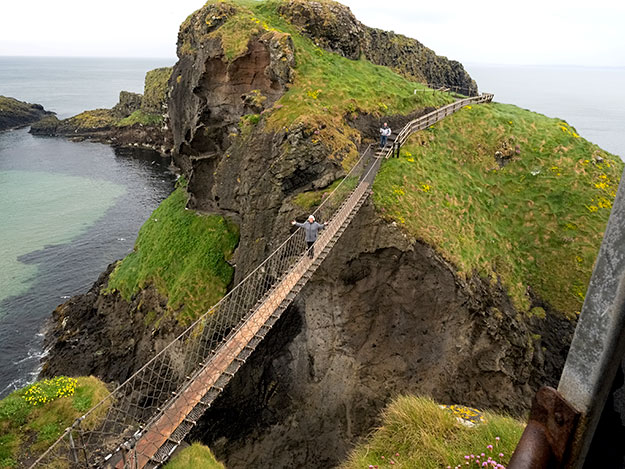
Today Carrick-a-Rede is as much a tourist attraction as a fishing operation. Thousands of visitors each year pay about $8 for the chance to cross the wobbly bridge. Most stop midway to peer down into the chasm far below their feet. I grasped the rope railings and scurried across. In the center, I looked up and posed for the camera, but I thought looking down was better left to a spot on firmer ground. On the other side I was rewarded with close up views of sea birds nesting on towering rocks covered with vividly green moss.

At the beginning of the day, I’d grumbled about the rain, but by the end of the day I’d had a change of heart. Northern Ireland is known for stormy weather and stupendous, moody scenery. Seeing it under these conditions made it so much more dramatic. Looking back, I wouldn’t have changed a thing.
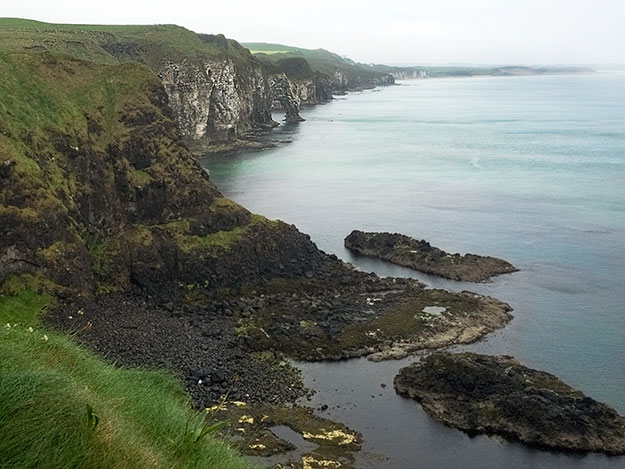
After visiting all seven continents and more than 100 countries, I have to say that road trips like my journey around Northern Ireland are the best way to travel. If, like me, you like to wander with few plans, you may want to check out this great article about the Best UK Road Trips on the Bridges & Balloons Travel Blog.
Author’s note: Frances charges 35 Pounds (about $48 USD) for the Glenara Elite Travel North Coast Tour. The price includes pickup and drop-off at your local hotel, but does not include lunch or admission fees to the sites. The walking trails at Giant’s Causeway and Carrick-a-Rede are free of charge, however fees are required to enter the Giant’s Causeway Visitor Center and to cross the rope bridge at Carrick-a-Rede. Oh, and remember to bring an umbrella.

Hi Barbara,
Thankyou for your wonderful written piece on your tour with us, the pictures and story does it proud, I hope it inspires more travellers to stay in the Causeway Coast and explore more of what we have to offer. Safe travels.
Frances x
You’re very welcome Frances. I hope my story inspires folks to contact you, because it’s the best way to see the Causeway Coast!
Hello Barbara
I regard your travelogues coming to roost in my computer each Monday as my ‘treat of the week’! You write very well, and you certainly manage to winkle out such very interesting information and stories, and backed up with stunning photographs. I’ve learnt and shared so much from your experiences.
Thank you, and go well.
Alison, you cannot begin to imagine how much your comment meant to me. Sometimes, I feel like I am writing into the wind, and I wonder if anyone ever reads my stories. So when I receive the rare comment that says how much what I do is appreciated, well, it just makes my day. Thank you SO MUCH!
Lovely post Barbara
Thank you so much Martin. xo
Dear Barb,
There is something magical about the Giant’s Causeway, as well as all of Ireland; and you have certainly captured it in your pictures and your prose. Our youngest son and daughter-in-law and our two grandsons will be visiting there beginning next week. I have forwarded them your blog as well.
We miss you here in VA/NC, but couldn’t be happier for you in your journey.
Love,
Vonnie
Hi Vonnie and John! So wonderful to hear from you, and to know something I wrote is helpful. I really, really wish I could see you guys again. Maybe I will come back for a brief visit next spring.